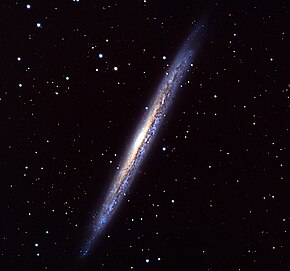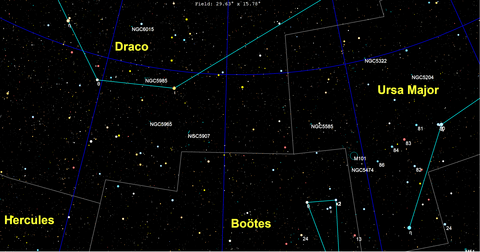NGC 5907
| NGC 5907 | |
|---|---|
 NGC 5907 | |
| Observation data (J2000 epoch) | |
| Constellation | Draco |
| Right ascension | 15h 15m 53.8s[1] |
| Declination | +56° 19′ 44″[1] |
| Redshift | 0.002225[1] |
| Heliocentric radial velocity | 667 ± 3 km/s[1] |
| Distance | 53.5 ± 8.1 Mly (16.4 ± 2.5 Mpc)[2] |
| Apparent magnitude (V) | 11.1[1] |
| Characteristics | |
| Type | SA(s)c: |
| Apparent size (V) | 12.7' x 1.4'[1] |
| Other designations | |
| H II.759, GC 4087, h 1917, Splinter Galaxy, NGC 5906, UGC 09801, PGC 054470, MCG +09-25-040[1] | |
NGC 5907 (also known as Knife Edge Galaxy or Splinter Galaxy) is a spiral galaxy located approximately 50 million light years from Earth.[2] William Herschel discovered the galaxy in 1788.
Characteristics
[edit]NGC 5907 has an anomalously low metallicity and few detectable giant stars, being apparently composed almost entirely of dwarf stars.[3] It is a member of the NGC 5866 Group.
NGC 5907 has long been considered a prototypical example of a warped spiral in relative isolation. In 2006, an international team of astronomers announced the presence of an extended tidal stream surrounding the galaxy that challenges this picture and suggests the gravitational perturbations induced by the stream progenitor may be the cause for the warp. The existence of part of these tidal streams has been recently challenged by some deeper surveys.
One supernova has been observed in NGC 5907: SN 1940A (type unknown, mag 14.3).[4][5]
An ultraluminous X-ray source is located in the galaxy.[6]
Location
[edit]- The edge-on galaxy is seen in the constellation Draco, near the star iota Draconis. It is seen in the sky near to the much more distant galaxy NGC 5965.
NGC Identification
[edit]NGC 5907 is also known as NGC 5906.[7][8] This second NGC number refers to a fainter part of the galaxy[7] lying west of the dust lane[8] that was recorded by astronomer and physicist George Johnstone Stoney on April 13, 1850.[7]
Gallery
[edit]-
Spiral galaxy NGC 5907, by HST.
References
[edit]- ^ a b c d e f g "NASA/IPAC Extragalactic Database". Results for NGC 5907. Retrieved 2010-07-11.
- ^ a b "Distance Results for NGC 5907". NASA/IPAC Extragalactic Database. Retrieved 2010-07-11.
- ^ Liu, M. C.; Marleau, F. R.; Graham, J. R.; Charlot, S.; Sackett, P.; Zepf, S. E. (December 1998). "Weighing the Stellar Content of NGC 5907's Dark Matter Halo". Bulletin of the American Astronomical Society. 30: 1258. Bibcode:1998AAS...193.0807L.
- ^ "List of Supernovae". Harvard-Smithsonian Center for Astrophysics (IAU). Retrieved 2010-07-11.
- ^ Transient Name Server entry for SN 1940A. Retrieved 28 March 2023.
- ^ Israel, Gian Luca; Belfiore, Andrea; Stella, Luigi; Esposito, Paolo; Casella, Piergiorgio; De Luca, Andrea; Marelli, Martino; Papitto, Alessandro; Perri, Matteo; Puccetti, Simonetta; Rodríguez Castillo, Guillermo A.; Salvetti, David; Tiengo, Andrea; Zampieri, Luca; D’Agostino, Daniele; Greiner, Jochen; Haberl, Frank; Novara, Giovanni; Salvaterra, Ruben; Turolla, Roberto; Watson, Mike; Wilms, Joern; Wolter, Anna (24 Feb 2017). "An accreting pulsar with extreme properties drives an ultraluminous x-ray source in NGC 5907". Science. 355 (6327): 817–819. arXiv:1609.07375. Bibcode:2017Sci...355..817I. doi:10.1126/science.aai8635. PMID 28219970. S2CID 206653306.
- ^ a b c "New General Catalog Objects: NGC 5900 - 5949". cseligman.com. Retrieved 2020-06-26.
- ^ a b "Your NED Search Results". ned.ipac.caltech.edu. Retrieved 2020-06-26.
External links
[edit]- NGC 5907 on WikiSky: DSS2, SDSS, GALEX, IRAS, Hydrogen α, X-Ray, Astrophoto, Sky Map, Articles and images
- Ghost of a Dwarf Galaxy (Fossils of the Hierarchical Formation of the Nearby Spiral Galaxy NGC 5907)
- Astronomy Picture of the Day: NGC 5907 (2008 June 19 )
- Fossils of the Hierarchical Formation of the Nearby Spiral Galaxy NGC5907 (arXiv:0805.1137)
- SEDS – NGC 5907
- Hunting ghosts Hunting ghosts: the iconic stellar stream(s) around NGC 5907 under scrutiny

